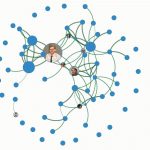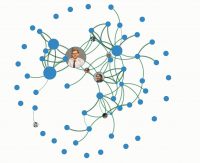Want To Be More Creative And Successful? Fight The Urge To Focus
In 1987, Mark Frauenfelder read an article in Whole Earth Review about the indie magazine revolution and thought to himself, “I’ve got to do a zine.” The next year, he and his wife started Boing Boing, a pop culture and technology publication. Frauenfelder was a mechanical engineer at the time; when Boing Boing launched in 1995 (first in print and then online), he kept his job in the disc-drive industry—and this was after he had joined the editorial team at Wired magazine two years earlier.
Frauenfelder did all this on the side and without any formal journalism experience, learning as he went and having fun every step of the way. He went on to found Make in 2005, a magazine that covered the growing “maker movement,” and a decade after that Frauenfelder self-published a book on magic tricks. He’s also an artist whose work graces the cover of Billy Idol’s 1993 album Cyberpunk.
This is just how Frauenfelder’s brain works; he can’t stay stuck on one thing for too long. “For better or for worse,” he told me, “I am really interested in a lot of different things, and trying things out myself to see what it’s like to actually experience producing media or other things is always interesting.”
That’s an underappreciated hallmark of successful creatives—they’re rarely specialists in just one thing. In fact, too much focus can prove risky.
The Rule Of The Portfolio
When asked, “What do you do?” most of us tend to answer with a one-word reply or start describing our work duties. But since when does a single job description define what a person is capable of? Whether we realize it or not, many of us assume that we’ll eventually have to commit to a certain path in life, spend most our career doing that one thing, and not veer too far from it or else sabotage our professional success. This, we think, is what mastery is all about.
It isn’t. Your career can always change and evolve—in fact, the most creative ones need to regularly. In order to thrive, you have to master more than one skill. In the Renaissance, people embraced this intersection of different disciplines, and those who blended them best were rightly called “masters.” Frauenfelder says he has a hard time answering when people ask what he does. “What I do is just pick one thing, and I’ll say, I’m a magazine editor, or a writer, or a blogger . . . I’m just generally a person who will do things that require creativity and communication.”
While it doesn’t fit neatly into a job description, Frauenfelder’s career rests on a rich, diverse portfolio that allows him to do interesting and creative work for a lifetime—even though it isn’t what you might call “focused.” But in order to thrive in new creative age, you have to master multiple crafts; one former Ideo designer writing for Fast Company last year, described the competitive advantage of the “comprehensivist”: Would you rather hire a writer who’s only good at crafting prose, or one who also understands marketing? Would you prefer to work for a boss who only knows how to treat people with respect? When we develop a diverse portfolio of work, we do better and more interesting work, and we tend to avoid becoming obsolete so quickly.
A Distractible Mind
That doesn’t mean creative professionals don’t genuinely struggle with a lack of focus. Sometimes it’s hard to commit to something and see it through to the end—but even this isn’t necessarily a bad thing. A wandering mind can be an asset if you learn how to use it.
In 1985 Michael Jackson famously paid $47.5 million for a music catalog that included 250 songs by the Beatles. At the time, people in the industry thought the deal was crazy, but Jackson knew the Beatles catalog was invaluable. In the decades since Jackson’s purchase, the value of those songs has increased more than 1,000%, to over $1.5 billion.
The acquisition was one of the greatest deals in music business history, but it wasn’t initiated by a producer or label executive. Had Jackson been focused solely on writing and performing his own music, he’d never have orchestrated an eight-figure acquisition of somebody else’s. But he was doing just what thriving artists do: He wasn’t going all-in on one big bet—he was diversifying his portfolio.
To spot the right places to invest your time and resources, you need what Darya Zabelina calls a “leaky mental filter.” A researcher who teaches at Northwestern University, Zabelina says there’s a link between creative achievement and the ability to hold multiple, conflicting ideas in mind at once. This preserves the tension between those ideas so that they naturally build upon one another. “People with leaky attention might be able to notice things that others don’t notice or see connections between things,” she told me, “which might lead to a creative idea or creative thought.”
That’s what allowed Michael Jackson to see something nobody else saw. It let Mark Frauenfelder work on Boing Boing and Wired at the same time, not to mention countless other projects. Both pursuits competed with each other for his time and energy, and both flourished. Under the right circumstances, being distractible can be a strength.
“If you think about the most creative people,” therapist Chuck Chapman told me, “they’re the ones who innovate. They come up with the ideas, and I think the fact that your brain is going so fast all the time and seeing so many possibilities—that’s what creates innovation.”
This article is adapted with permission from Real Artists Don’t Starve: Timeless Strategies for Thriving in the New Creative Age by Jeff Goins.
A wandering mind can be an asset if you learn how to use it.
In 1987, Mark Frauenfelder read an article in Whole Earth Review about the indie magazine revolution and thought to himself, “I’ve got to do a zine.” The next year, he and his wife started Boing Boing, a pop culture and technology publication. Frauenfelder was a mechanical engineer at the time; when Boing Boing launched in 1995 (first in print and then online), he kept his job in the disc-drive industry—and this was after he had joined the editorial team at Wired magazine two years earlier.
Fast Company , Read Full Story
(15)













